In this post you will find algae examples, their characteristics and detailed facts.
Algae are non-vascular photosynthetic aquatics that produce auxiliary spores for asexual reproduction and non-jacketed sex parts for sexual reproduction.
Algae examples:
Chlamydomonas
Chlamydomonas is a common resident in ammonium-rich fresh and marine environments. Water bloom is caused by excessive growth of the alga . Only a few species can grow in the snow, they are called Cryophytes, such as C.nivalis and C.yellowstonensis, are among them.
Chlamydomonas is a minute green alga with a length of 10-30μm. A mucilage coating surrounds the algae. Glycoproteins and non-cellulosic polysaccharides make up the cell wall. Dictyosomes, mitochondria, endoplasmic reticulum, and ribosomes are examples of cytoplasmic structures. In the cytoplasm, there is usually a single big basin-shaped chloroplast. It has one or more pyrenoids for starch storage and a number of photosynthetic lamellae with 2-20 thylakoids per lamella.
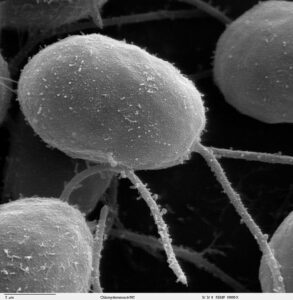
Volvox
It’s also known as rolling alga or rolling ball. Volvox is a green colonial alga that can be found in fresh water ponds, pools, and lakes. Because it has a constant number of cells, the colony is also known as coenobium.
All of the cells are organized in a ring around the outside of a tougher mucilage membrane. Watery mucilage covers the colony’s center. Biflagellate cells have 2-6 contractile vacuoles, a single nucleus, a single chloroplast with a stigma, and one or more pyrenoids.
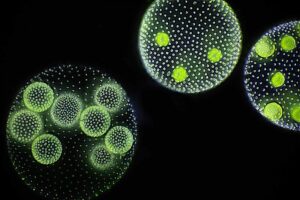
Individual cells coordinate their flagellar motions to help the colony swim in water. Gonidia, or reproductive cells, are larger than the other somatic cells. Daughter colonies are formed during asexual reproduction. Oospores are produced during sexual reproduction (Oogamous).
Ulothrix
Algae (green algae) Ulothrix thrives in aerated fresh water such as rain puddles, lakes, tanks, springs, and slow-moving streams. It has a 30cm long unbranched filament. An elongated non-green cell termed a holdfast or rhizoid attaches the filament to the substratum.
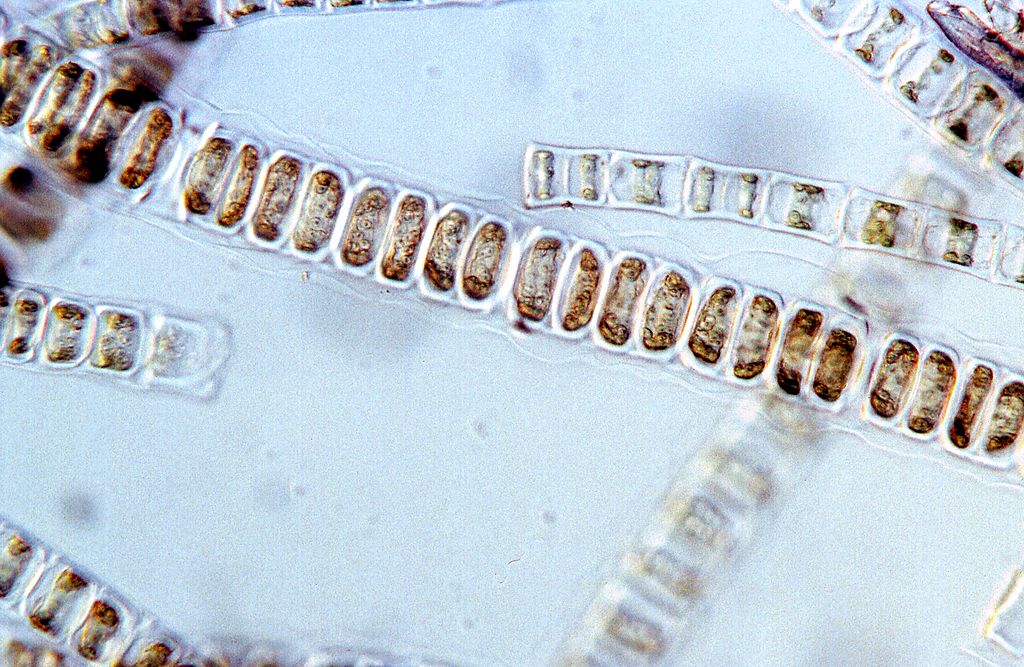
In the surrounding cytoplasm, each cell possesses a central vacuole and a single collar-like parietal chloroplast. The nucleus and other organelles can also be found in this cytoplasm. For starch storage, chloroplast contains one or more pyrenoids.
Spirogyra
It’s a silky green alga that floats freely in stagnant fresh water like ponds and ditches. It is a 1 metre long unbranched filament. The filament is made up of a single file of elongated cylindrical green cells stacked one on top of the other. A mucilage sheath surrounds the entire filament.
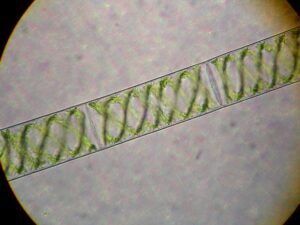
A huge central vacuole is crossed by cytoplasmic threads in each cell. These strands hold the nucleus in place at the center. In S.sahnii and S.rectispora, the peripheral cytoplasm contains 1-16 chloroplast, respectively. Spiral-coiled ribbons make up chloroplast. A row of tiny nodules, similar to pyrenoids, can be found on each chloroplast.
Over them, pyrenoids store starch. Vegetative reproduction is accomplished through fragmentation. Asexual reproduction is extremely uncommon. The scalariform and lateral kinds of conjugation are used in sexual reproduction.
Few species, such as S.adnata and S.jogensis, are found affixed to solid substrate.
Chara
It’s a green alga that grows on the bottoms of shallow ponds, pools, and lakes. Because of its jointed look, the alga is also known as aquatic horsetail. The axis and rhizoids make up the plant’s body.
The upright jointed section of the axis called the stem. Branchlets are whorled at the joints or nodes. Each branchlet has four to fifteen segments. Secondary laterals emerge from the nodes of branchlets. Small cells are found in nodes, while long cells are found in internodes. Rhizoids are multicellular filaments with oblique septa that are not green. They penetrate the substratum and aid in the fixing process.
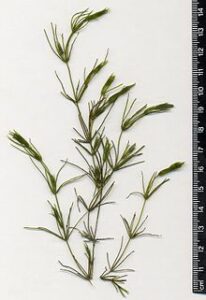
Fragmentation, tubers, bulbils, amylum stars, and secondary protonemata are all used to multiply Chara vegetatively.
Sexual reproduction is oogamous. Antheridium or globule is the male sex organ. The oogonium or nucule is the female sex organ.
Fucus
It’s a brown marine alga. There are over 100 species of fucus globally, however none are found in India. The plant body is well branched, with fronds, a small stipe, and a holdfast that aids in attachment to the substratum.
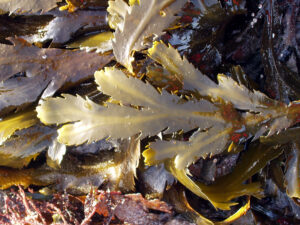
Some species, such as F.vesiculosus, have air bladders. The fertile receptacle is located at the end of the branch, and the frond surface has a number of pores known as cryptostomata or cryptoblast. Again, there are two types of reproduction: vegetative and sexual. Vegetative reproduction is accomplished through fragmentation or adventitious branches, while sexual reproduction is accomplished through external fertilization. In nature, F.spiralis is monoecious, whereas F.vesiculosus is dioecious.
Laminaria
It is a 2m long marine brown alga. The body is separated into three sections: lamina, stipe, and holdfast. Lamina can be solitary or multi-segmented (L.saccharina and L.digitate) respectively.
Vegetative, sexual, and asexual reproduction are all possible. The emergence of stolon from the holdfast allows for vegetative reproduction. Sexual reproduction is fully external, antherozoids and eggs are discharged outside the body, and asexual reproduction is done by producing zoospores.
Characteristics of algae:
- Algae can be found in both saltwater and freshwater environments. Damp soil, wet rocks, tree trunks, and other moist terrestrial habitats are also home to several species. It’s possible that they’re epiphytes or epizoics.
- Algae of the kingdom Plantae are multicellular in nature. However, due to their ultrastructure and reproductive similarities, a number of unicellular (Chlamydomonas) and colonial (Volvox) algae are listed among them.
- A thallus is the plant’s main body. Filament is the most basic form. There is a holdfast for attachment. Kelp algae resemble palms, ferns, and other plants on the outside. They have a lamina-like leaf and a stipe-like stalk.
- Size ranges from microscopic(Chlorella) to macroscopic (Macrocystis).
- The mucilage covers the entire body. Mucilage shields algae from desiccation, epiphytic development, harmful compounds, and water degradation.
- Algae, unlike land plants, do not require water to be carried.
- Algal photosynthetic plastids come in a variety of forms and colours. Pyrenoids are found in several of them. Pyrenoids are involved in the storage of starch in green algae. Others are completely bare. Green algae’s plastids are named chloroplast, while others are called chromatophores.
- Agranal plastids are those that lack grana. 1-20 thylakoids make up its photosynthetic lamellae.
- All contain chlorophyll a, carotenes, and xanthophylls. Fucoxanthin and chlorophyll c in brown algae are examples of extra photosynthetic pigments found in each algal group.
- Every algal community has its own specific reserve food. Red algae produce floridean starch, while brown algae produce laminarin.
- Fragmentation, tubers, stolons, adventitious branches, and other means of vegetative reproduction are used.
- Asexual reproduction is carried out by zoospores, aplanospores, hypnospores, akinetes, autospores, tetraspores, and other accessory spores. Among these, zoospores are flagellate spores formed under favourable conditions. Each zoospore comes to rest after swimming for a while and germinates to generate a new plant.
- Isogamy, anisogamy, oogamy, spermatization, and other methods of sexual reproduction are used.
- All aquatic ecosystems rely heavily on algae for production. They generate energy rich organic compounds are the basis of food cycles for all aquatic animals.
- Algae fixes over half of the total world CO2 through photosynthesis. They aerate the aqueous medium by releasing oxygen.
- Proteins, vitamins, and minerals abound in chlorella and spirulina. They are utilized as a food supplement and are a rich source of single cell protein.
- Medicinal qualities are found in Codium, chlorella, Laminaria, and Durvillaea.
- To provide oxygen to decomposer organisms, aerobic algae are cultured in sewage oxidation tanks.
- Several algae species grow on the hulls of ships, causing fouling.
- Algae are used to extract bromine, iodine, and potash.
Also Read:
- Is endocytosis diffusion
- Do plant cells have ribosomes
- Atp synthesis stages
- Finger anatomy
- How are enzymes produced
- Brown algae examples
- Plant chromosomes structure
- Spider characteristics
- Do prokaryotic cells have a cell wall
- Function of flagella

Hi, I am Saif Ali. I obtained my Master’s degree in Microbiology and have one year of research experience in water microbiology from National Institute of Hydrology, Roorkee. Antibiotic resistant microorganisms and soil bacteria, particularly PGPR, are my areas of interest and expertise. Currently, I’m focused on developing antibiotic alternatives. I’m always trying to discover new things from my surroundings. My goal is to provide readers with easy-to-understand microbiology articles.
If you have a bug, treat it with caution and avoid using antibiotics to combat SUPERBUGS.
Let’s connect via LinkedIn: